Overview
In the fast-paced world of software development, developers often face significant coding challenges that can hinder productivity and code quality. The article titled "10 Essential Features of a Test Runner JS for Developers" addresses these issues by outlining the crucial functionalities that a JavaScript test runner should possess to enhance the development and testing process.
How does Kodezi help tackle these challenges? By incorporating features such as:
- Built-in coverage support
- API mocking
- Test concurrency
- TypeScript compatibility
Kodezi streamlines testing workflows and facilitates efficient debugging. These features collectively improve code quality and address common obstacles developers encounter.
The benefits of using Kodezi are substantial. Developers can expect improved productivity and a more organized testing process, leading to higher-quality code. Furthermore, with the right tools at their disposal, teams can focus on what truly matters—delivering exceptional software.
Explore the tools available on the Kodezi platform to elevate your development experience. By leveraging these essential features, you can transform your testing practices and overcome the hurdles that often impede progress.
Introduction
In the fast-evolving landscape of software development, developers face numerous challenges that demand efficiency and quality. How can they overcome these obstacles? Enter Kodezi, a powerful OpenAPI Specification generator that automates API documentation, significantly enhancing testing efficiency. This article explores how Kodezi, alongside the Node.js test runner, simplifies testing and empowers developers to produce high-quality software.
Imagine the impact of improved code coverage and API mocking on your projects. With Kodezi, modern developers can leverage strategies that optimize workflows, such as test concurrency and customizable reporting. These features not only streamline processes but also elevate the overall quality of the software produced. As the demand for reliable and efficient testing solutions grows, understanding these advancements is crucial for staying ahead in the competitive tech landscape.
Are you ready to explore the transformative capabilities of Kodezi? Discover how these tools can enhance your development experience and lead to superior products.
Kodezi | Professional OpenAPI Specification Generator - AI Dev-Tool: Boost Your Testing Efficiency
Developers face numerous challenges in the coding process, particularly when it comes to documentation. Kodezi functions as a robust OpenAPI Specification generator, significantly enhancing evaluation efficiency for programmers. By automating the generation of API documentation, Kodezi allows developers to focus on coding rather than being bogged down by manual documentation tasks. This automation not only saves valuable time but also ensures that API specifications remain current and adhere to industry standards, which is vital for effective evaluation and integration.
As organizations strive to enhance their software development lifecycle, the API Testing market is projected to grow, driven by technological advancements like AI and ML. For instance, the Healthcare segment is estimated to expand at a CAGR of 18.5% from 2023 to 2032. Practical examples demonstrate that tools such as Kodezi not only streamline the documentation process but also improve overall evaluation outcomes. A case study on LoadFocus illustrates how integrating automated performance evaluation into workflows provides critical insights for enhancing web applications, ensuring an exceptional user experience as user demands increase.
As one industry leader noted, "Tools like LoadFocus provide the insights needed to optimize your web applications, ensuring they can handle real-world traffic while delivering an excellent user experience." This highlights Kodezi's role as an indispensable asset for contemporary development workflows, empowering over 1,000,000 programmers to elevate their coding skills and productivity. Furthermore, Kodezi CLI offers features that enable teams to swiftly AutoHeal codebases, further boosting programming efficiency and aligning with Agile Testing principles.
Are you ready to enhance your coding practices? Explore the tools available on the Kodezi platform and experience the benefits firsthand.
Node.js Test Runner: Simplified Testing Process for Developers
In the world of coding, developers often grapple with intricate configurations and time-consuming setups. How can they streamline their processes? The Node.js execution runner transforms the evaluation process by offering a built-in framework that minimizes configuration needs. This innovation allows creators to write and run evaluations effortlessly, integrating seamlessly with their Node.js applications. By simplifying the approach, setup time is significantly decreased—averaging a reduction of up to 50%—which enables developers to focus on crafting efficient evaluations rather than navigating complex configurations.
Supporting various assessment styles, the runner adapts to diverse project needs, playing a crucial role in maintaining high code quality. With the explosive growth of Node.js, evidenced by 271,694 companies adopting it in 2024, the demand for efficient testing solutions is on the rise. Insights from the case study titled 'Node.js's Global Adoption Trends' further emphasize that this growth signals a promising future for Node.js as a preferred technology for building real-time and scalable applications. Consequently, test runner js in Node.js has become a vital resource for contemporary programmers.
Furthermore, Kodezi's AI-powered automated debugging enhances this process by allowing programmers to quickly identify and resolve issues in the codebase, such as performance bottlenecks and security compliance, ensuring adherence to the latest coding standards. As we look ahead to 2025, staying informed about the latest trends is essential; these runners are increasingly critical for boosting productivity and ensuring high-quality programming. Why not explore the tools available on the Kodezi platform and elevate your coding experience?
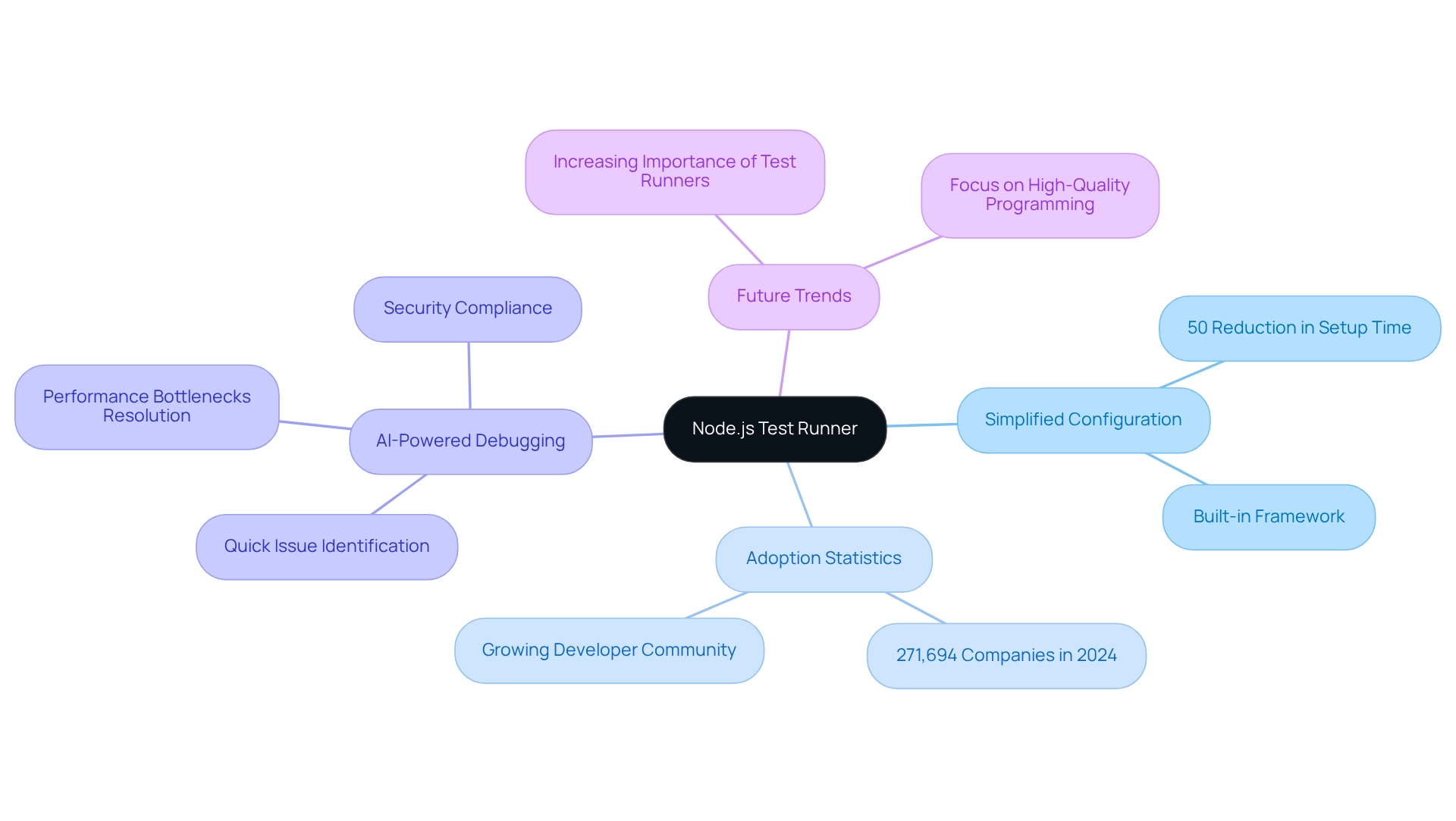
Code Coverage: Ensure Comprehensive Testing with Node.js Test Runner
Code coverage serves as a crucial metric that quantifies the percentage of a program executed during evaluation, providing programmers with valuable insights into the effectiveness of their testing efforts. Have you ever wondered how you can identify untested areas in your codebase? Node.js test runner js come equipped with built-in features to gather coverage data, enabling developers to pinpoint these gaps. By thoroughly analyzing these metrics, teams can ensure comprehensive evaluation, which is vital for maintaining software reliability.
Research shows that high test coverage is often associated with a reduction in bugs and an overall enhancement in quality. This underscores its significance in the development process. Kodezi’s AI-driven automated builds streamline this workflow by incorporating evaluations that identify issues before they escalate, thereby improving software quality with each release. Once coverage is solid, programmers can confidently submit their contributions to the repository, reinforcing the practical advantages of achieving high code coverage.
In the realm of Node.js, using a test runner js with integrated coverage support not only boosts evaluation efficiency but also fosters a culture of quality assurance within development teams. However, it's essential to recognize that while 100% code coverage may seem ideal, as one anonymous source noted, achieving high coverage is a critical step toward ensuring robust and reliable software.
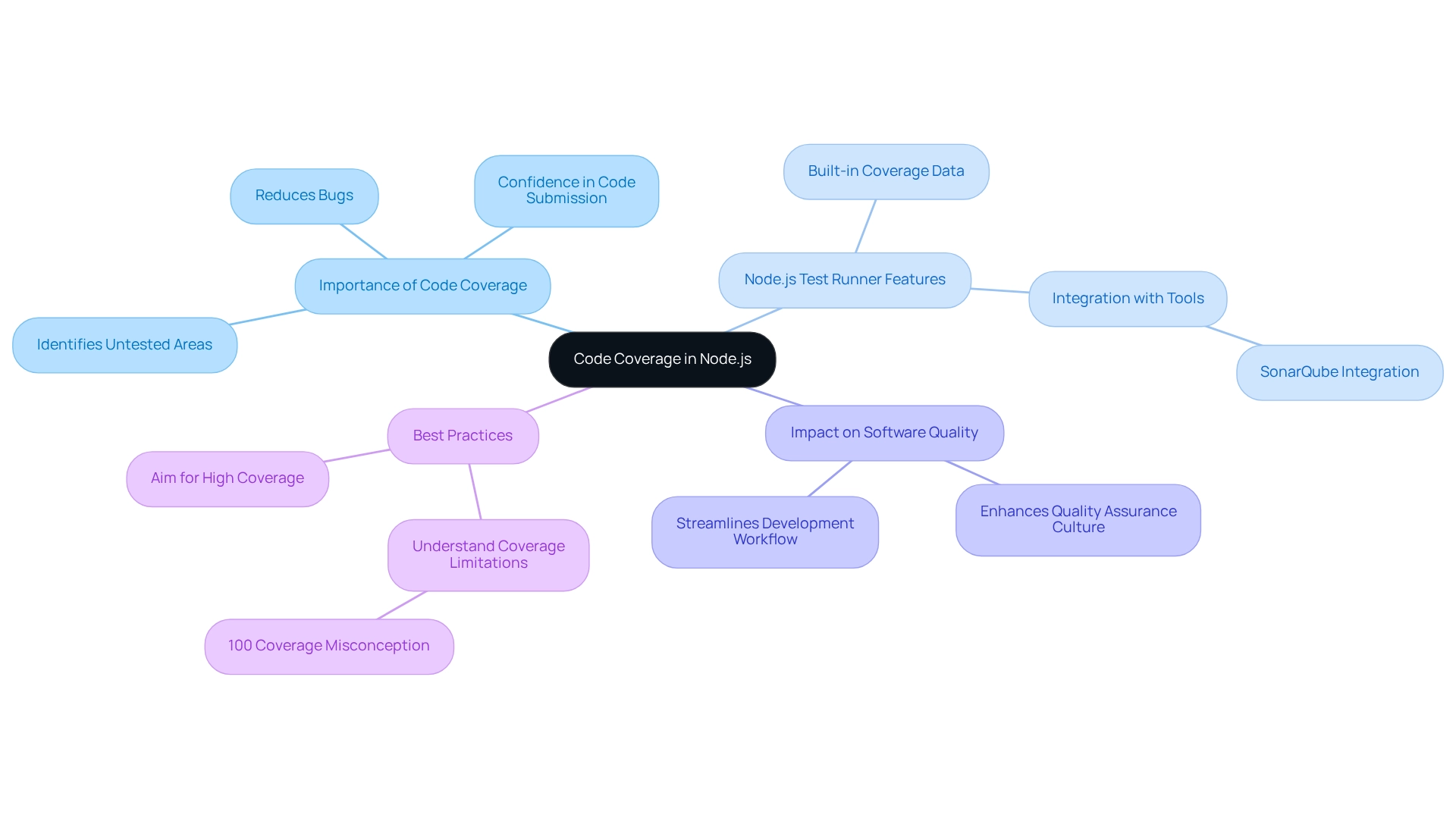
API Mocking: Test Interactions Without External Dependencies
API mocking addresses significant challenges that developers encounter, particularly when dealing with external APIs. By simulating the behavior of these APIs, developers can conduct thorough testing of interactions without relying on actual services. This approach is particularly valuable when external APIs are unavailable or experiencing latency, which can disrupt evaluation workflows. Mock APIs empower programmers to ensure their applications function reliably under various conditions, ultimately leading to more robust software solutions.
The advantages of API mocking extend beyond mere availability; it enhances the reliability and speed of assessments. A recent study revealed that:
- 100% of participants favored Mockito for mocking
- 64.7% opted for EasyMock
- 35.3% for PowerMock
This highlights the popularity of these tools within the programming community. Furthermore, as one experienced contributor noted, "As per my experience, this can accelerate product iterations by 30-40%," underscoring the significant efficiency gains achievable through effective mocking practices.
Tools like Kodezi simplify the generation of mock APIs, enabling developers to create these essential evaluation components swiftly. Kodezi's CLI tool streamlines the evaluation process, boosting programming productivity by allowing teams to auto-heal codebases quickly. This capability ensures that applications can undergo rigorous testing without external dependencies, fostering a more efficient development cycle. As the software development landscape evolves, incorporating advanced API mocking tools will remain crucial for improving evaluation methods and ensuring high-quality software delivery.
Test Hooks: Manage Setup and Teardown Efficiently
In the realm of software development, coding challenges are a common hurdle that developers face. Hook functions are crucial routines that run before and after evaluations, enabling programmers to effectively manage setup and teardown activities. By utilizing these hooks, developers can establish the evaluation environment and ensure proper cleanup afterward, which is essential for maintaining a consistent state across evaluations. This approach significantly reduces the likelihood of side effects between assessments, thereby enhancing the reliability of results. Recent insights reveal that incorporating evaluation hooks can streamline workflows and minimize errors, ultimately boosting overall productivity.
The test runner js for Node.js execution supports a variety of hooks, making it easy for developers to integrate these practices into their evaluation routines. For instance, enhancing Playwright hook functions has resulted in a notable increase in execution speed and a reduction in resource consumption for complex applications, ensuring that evaluation suites function seamlessly and reliably. As Nishil Patel, CEO & Founder, states, "We customize hooks to reduce resource consumption, enhance testing speed, and prevent common issues, ensuring your evaluation suites operate seamlessly and reliably." Optimal methods for utilizing hooks involve creating clear setup and teardown procedures, which can significantly enhance efficiency in evaluations.
Furthermore, industry leaders emphasize the importance of these processes in evaluation. Effective setup and teardown not only improve reliability but also contribute to total defect containment, reflecting the overall effectiveness of evaluation in identifying issues before release. This concept of total defect containment is vital, as it underscores the significance of thorough testing in preventing defects from reaching production. Additionally, with 11.2% of software testers speaking German as their second language, the global relevance of these practices highlights their importance in diverse development environments.
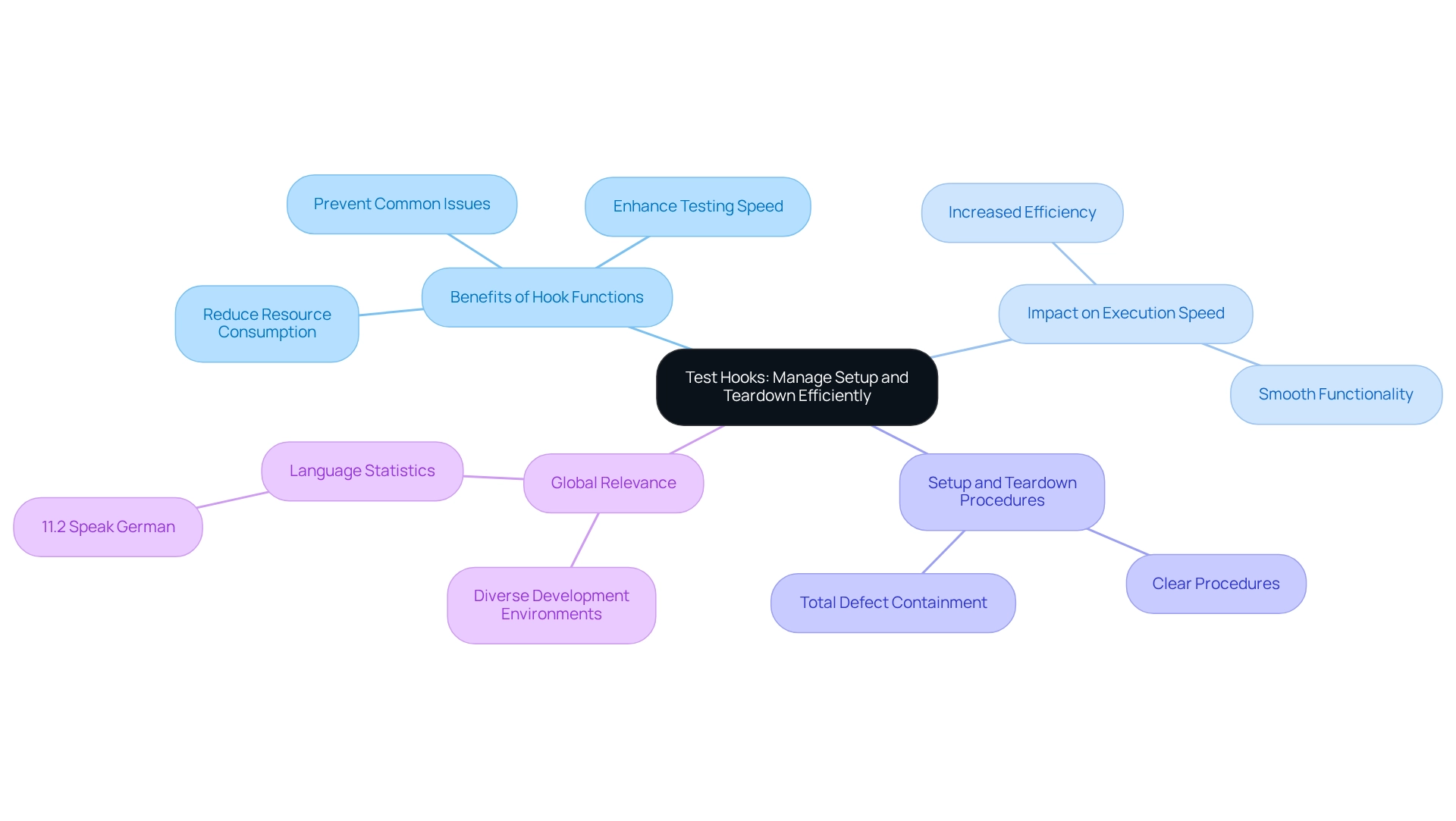
Test Reporters: Gain Insights into Your Testing Outcomes
Coding challenges can be daunting for developers, often leading to inefficiencies and frustration. Quality assurance reporters play a crucial role in the software creation process by utilizing test runner js to provide a concise overview of execution outcomes that equip programmers with practical insights. These tools provide essential information through the test runner js, including the status of tests—whether they passed or failed—execution times, and detailed error messages. By analyzing these reports, developers can swiftly identify code issues and prioritize necessary fixes, ultimately enhancing code quality.
In 2025, the significance of assessment reporters has only grown. Numerous teams are embracing sophisticated reporting tools that foster transparency and shared responsibility for quality. End-of-sprint reports frequently feature metrics such as coverage, defect density, and the status of user stories, enabling teams to evaluate their progress thoroughly. These metrics are vital for understanding the overall health of the codebase and pinpointing areas that require attention.
Furthermore, the rise of custom test reporters has been notable as developers utilize a test runner js to tailor outputs to their specific needs, thereby improving their monitoring capabilities. A case study showcasing the expansion of Selenium alternatives, like Cypress and Playwright, illustrates this trend; these tools are favored for their user-friendly attributes and strong evaluation capabilities, which include improved reporting functionalities that meet the requirements of contemporary development teams.
In addition, integrating automated programming debugging tools, like those provided by Kodezi, can significantly enhance the testing process. These tools allow developers to instantly identify and fix codebase issues, providing detailed explanations of what went wrong and how it was resolved. This ensures compliance with the latest security best practices and coding standards. Swift problem resolution not only improves performance but also enhances overall software quality, making it easier for teams to uphold high standards in their applications.
Expert insights underscore the importance of these tools, with one principal engineer noting, "Automation is an accelerator, not a replacement. It's about putting brains in your muscles." This highlights how automation enhances the efficiency of testing processes, particularly through Kodezi's capabilities. As the landscape of assessment reporting continues to evolve, developers are increasingly leveraging these insights to refine their code quality monitoring strategies, ensuring that their applications meet the highest standards.
To effectively implement evaluation reporters in your development process, consider personalizing your reporting tools to align with your team's specific metrics and objectives. This will not only enhance your monitoring capabilities but also foster a culture of transparency and collective ownership of quality.
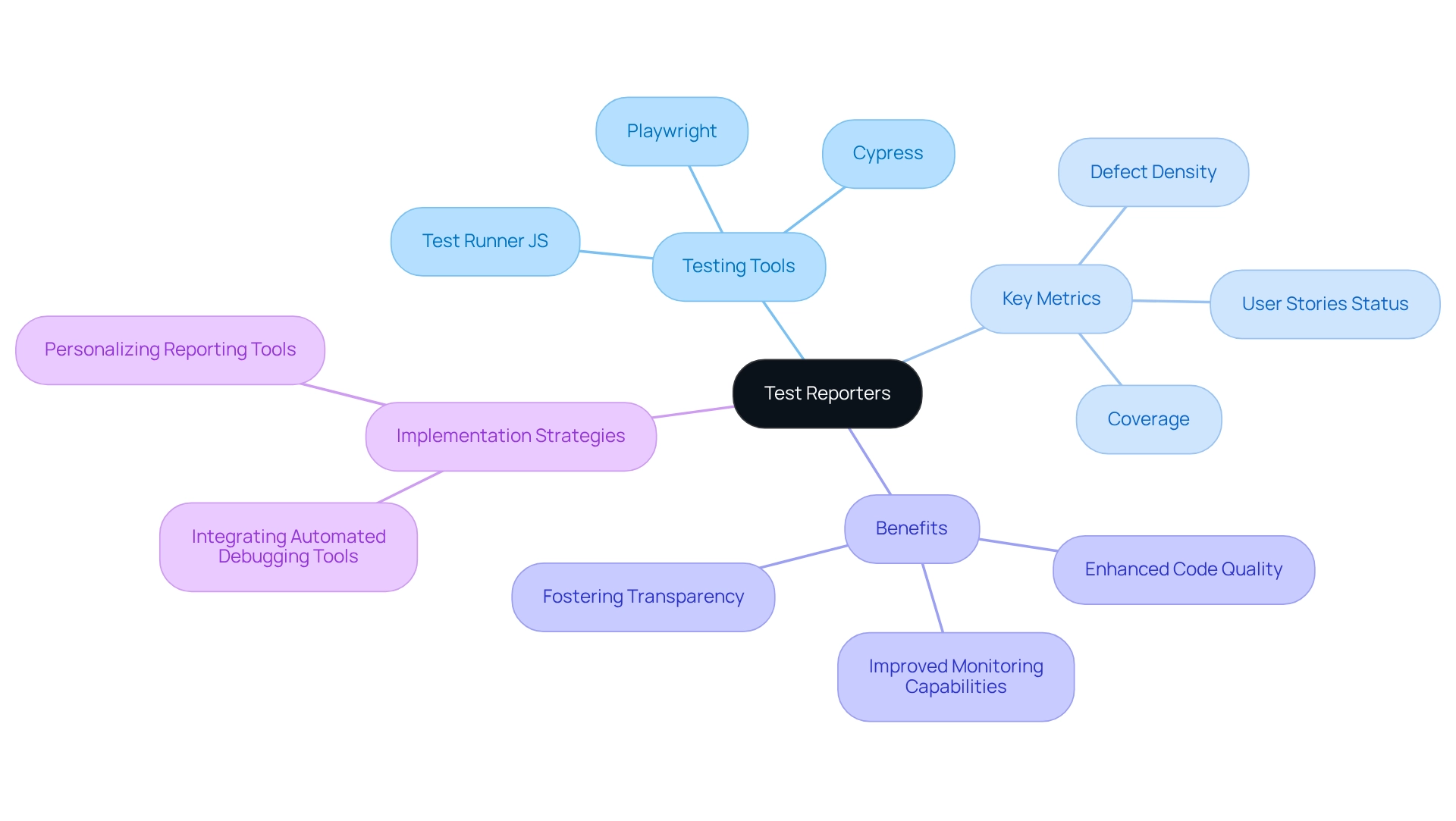
Test Concurrency: Speed Up Your Testing Process
Concurrency allows several evaluations to occur simultaneously, significantly accelerating the entire assessment process. This method proves particularly advantageous for large applications with extensive verification suites, where sequential execution often results in considerable delays. By leveraging the test runner js's support for concurrent execution, developers can streamline their workflows. This not only facilitates faster issue detection but also enhances development cycles, leading to quicker release timelines. In fact, implementing concurrent execution can reduce evaluation time by an average of 30-50%, enabling teams to focus on building features rather than waiting for evaluations to complete.
Best practices, such as developing independent evaluations and avoiding static objects, further ensure that parallel assessments yield reliable results without interference. As highlighted in the case study 'Best Practices for Parallel Evaluation,' adhering to these practices is essential for effective parallel evaluation. Additionally, key metrics to monitor in concurrency testing include:
- Concurrent users
- Latency
- Throughput
- Error rate
These metrics are vital for assessing the performance of your tests.
Moreover, integrating Kodezi's automated debugging capabilities can significantly enhance this process. Kodezi empowers programmers to swiftly identify and resolve codebase issues, effectively addressing performance bottlenecks and security vulnerabilities. This optimization not only streamlines the evaluation process but also ensures adherence to the latest coding standards, further enhancing code quality.
As Martin Schneider, Delivery Manager at Optimizely, states, "Optimizely reduces programmer discomfort by shifting evaluations to the cloud," underscoring the importance of enhancing assessment workflows through concurrency. Furthermore, parallel evaluation can be particularly advantageous in regression scenarios with updated versions of applications, ensuring that new changes do not introduce issues.
To implement concurrent execution efficiently, programmers should focus on:
- Creating autonomous evaluations
- Regularly assessing their evaluation framework to uphold high-quality standards in software development.
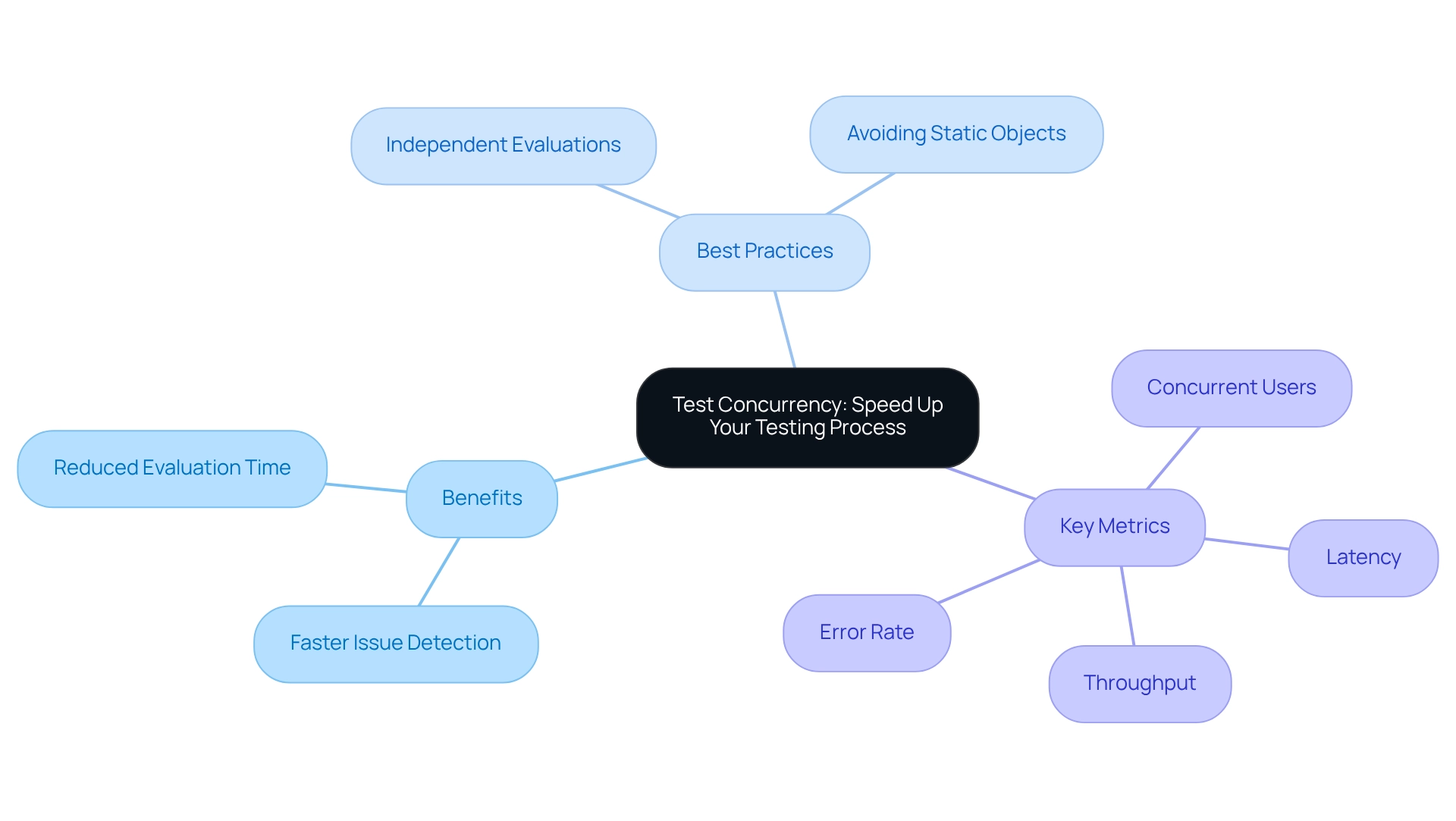
Customizable Test Reports: Tailor Outputs to Your Needs
In the world of software development, programmers often encounter challenges when it comes to effectively communicating evaluation results. Customizable assessment reports address these challenges by enabling developers to adjust the output of their evaluation results to meet specific project needs. This adaptability significantly enhances communication among team members and stakeholders by presenting information in the most relevant format, and the test runner js plays a crucial role here, facilitating the creation of custom reporters. Developers can specify how test results are displayed and which information is included, allowing teams to emphasize critical insights. By tailoring reports, teams can improve decision-making and prioritize necessary fixes, ultimately enhancing productivity and code quality.
As the software evaluation landscape evolves, the ability to create personalized reports is becoming increasingly vital. Furthermore, automated testing is essential in agile development, catching bugs before they multiply and ensuring high code quality with each release. This integration into the existing release process allows teams to deploy changes efficiently while maintaining high standards.
Emerging technologies, such as voice-enabled reporting and predictive analytics, are poised to transform how evaluation reports are created and used. These advancements improve team communication by making insights more actionable for stakeholders. The trend towards customizable assessment reports is anticipated to expand, with statistics suggesting that development teams are progressively embracing these tailored outputs to enhance their workflows and communication. Are you ready to explore the tools available to elevate your coding practices?
TypeScript Support: Enhance Your Testing with Strong Typing
Developers often encounter significant coding challenges that can lead to runtime errors and decreased code quality. TypeScript support in testing frameworks addresses these issues effectively by providing strong typing, which diminishes runtime errors and enhances overall quality. By utilizing TypeScript, programmers can detect type-related problems during the development stage rather than facing them at runtime, thus improving the dependability of their assessments.
Furthermore, the compatibility of test runner js with TypeScript allows for writing tests in a strongly typed manner. This not only enhances quality but also promotes better collaboration among team members. Clearer contracts for function inputs and outputs ensure that all team members are aligned on expectations, fostering a more productive environment.
As the adoption of TypeScript continues to expand, with a significant portion of programmers incorporating it into their workflows, the advantages of strong typing in assessment frameworks become increasingly apparent. Developers have reported that this approach significantly improves their ability to catch errors early, leading to more robust and maintainable codebases. In addition, Kodezi's AI-powered automated debugging enables programmers to quickly detect and resolve performance bottlenecks and security concerns, thereby improving overall quality and ensuring adherence to security best practices.
This integration of automated debugging into the evaluation process not only accelerates issue resolution but also enhances code quality. Manuel Aparicio aptly states, "The future of TypeScript seems limitless!" This sentiment reflects the continuous development of TypeScript tools and best practices, making it crucial for programmers seeking to improve their evaluation methods.
As creators adapt to the diverse array of software categories being produced, incorporating TypeScript in assessment frameworks aligns with ongoing trends. This guarantees that evaluation practices progress in tandem with creator preferences. To maximize the advantages of TypeScript in your evaluation workflows, consider integrating Kodezi's debugging features to streamline your development process.
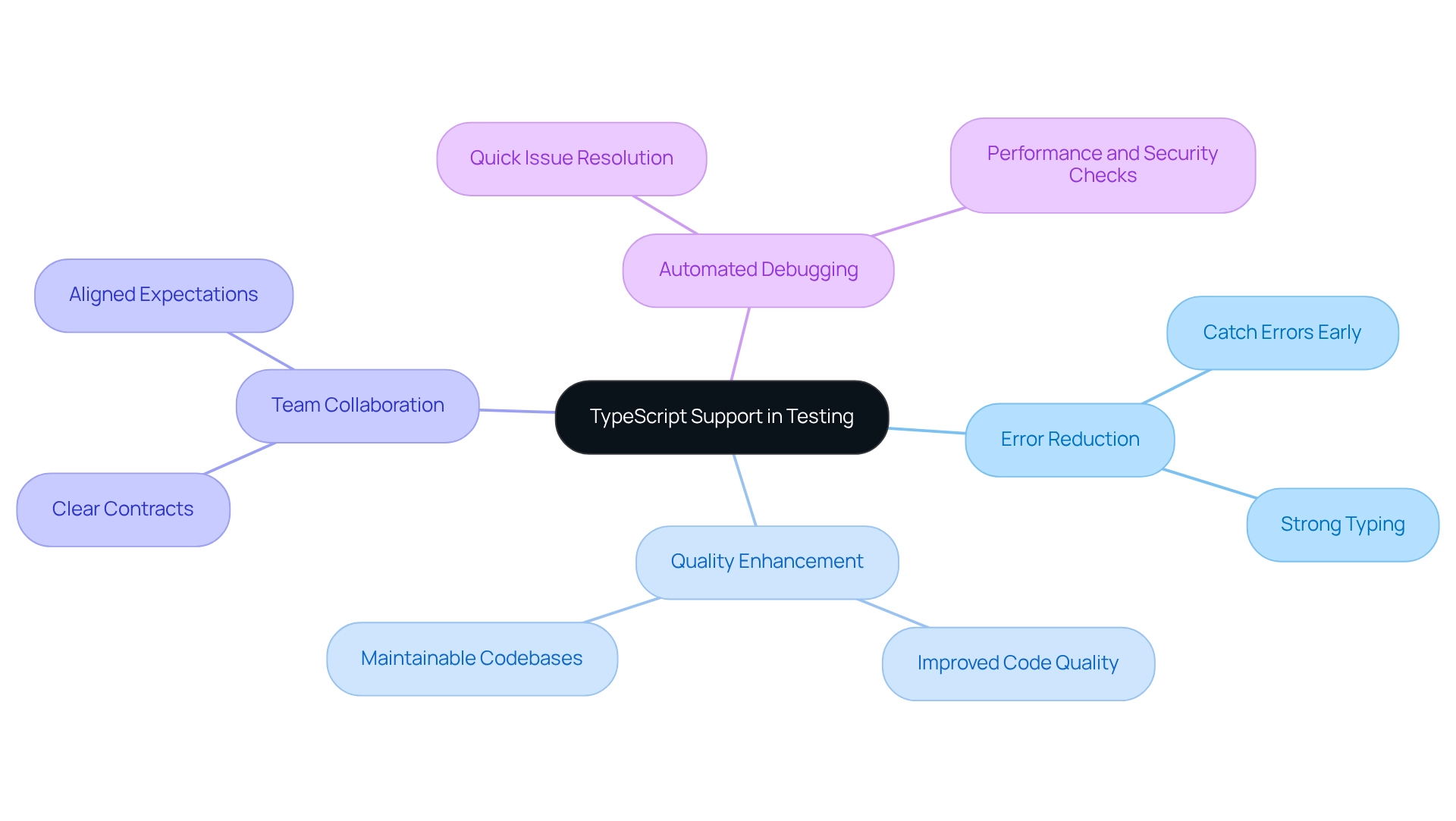
Upcoming Features: Stay Ahead with the Latest Enhancements
Staying informed about the latest functionalities in evaluation instruments is essential for programmers aiming to improve their workflows. The Node.js execution runner is constantly evolving, with updates designed to enhance its capabilities. By actively tracking these updates, programmers can integrate new features that refine their testing processes, including:
- Advanced coverage tools
- Improved mocking capabilities
- More efficient test execution strategies
This proactive approach not only keeps teams competitive but also enables them to deliver high-quality software more effectively.
Automated debugging of software is crucial in this context, allowing programmers to swiftly identify and address issues within the codebase. Tools like Kodezi empower developers to access detailed explanations of errors and their resolutions, ensuring adherence to the latest security best practices and coding standards. This functionality not only elevates code quality but also optimizes performance by addressing:
- Bottlenecks
- Identifying security vulnerabilities
- Implementing exception handling
- Refining code formatting
These elements are vital in agile development environments.
As Pranjal Mehta, Managing Director at Zealous, points out, "With over 10 years of experience and a global clientele, he remains committed to staying ahead in the market by adopting the latest technologies and trends." This perspective underscores the importance of integrating new features in evaluation tools to maintain a competitive edge.
Recent statistics reveal an increasing interest among developers in leveraging new testing tool features, such as ensuring the integrity of policy files with the command: node --experimental-policy=policy.json --policy-integrity='sha384-zzzzz'. Engaging with the community and contributing to the development of tools like the test runner js can further enhance these initiatives. For example, the community is encouraged to participate in the Node.js test runner js by enhancing documentation and providing feedback, fostering a collaborative environment that drives innovation.
Conclusion
The challenges faced by developers in software development are significant, particularly in ensuring code quality and efficient testing. Tools like Kodezi and the Node.js test runner are at the forefront of addressing these challenges. By automating API documentation and streamlining testing processes, Kodezi significantly enhances efficiency. This allows developers to concentrate on building robust applications rather than getting lost in manual tasks. Features such as:
- API mocking
- Test concurrency
- Customizable reporting
empower teams to produce high-quality software with greater speed and reliability.
Furthermore, the focus on code coverage and the utilization of test hooks demonstrate a commitment to thorough testing practices. This ensures applications are resilient and ready for real-world challenges. With the increasing importance of TypeScript support and customizable test reports, developers can tailor their testing strategies to meet specific project needs while upholding high coding standards.
In addition, as the landscape of software development continues to evolve, staying informed about the latest enhancements and embracing innovative tools becomes crucial for maintaining a competitive edge. Leveraging the capabilities of Kodezi and the Node.js test runner not only accelerates the testing process but also fosters a culture of quality assurance within development teams. Ultimately, these advancements signal a promising future for software development, where efficiency and quality go hand in hand, leading to superior products that meet the demands of an ever-changing market.
Frequently Asked Questions
What challenges do developers face in the coding process?
Developers often encounter difficulties with documentation, intricate configurations, and time-consuming setups during the coding process.
How does Kodezi assist developers with documentation?
Kodezi functions as an OpenAPI Specification generator, automating the generation of API documentation, which allows developers to focus on coding rather than manual documentation tasks.
What are the benefits of automating API documentation with Kodezi?
Automating API documentation saves time and ensures that specifications remain current and adhere to industry standards, which is crucial for effective evaluation and integration.
What is the projected growth of the API Testing market?
The API Testing market is expected to grow due to technological advancements like AI and ML, with the Healthcare segment estimated to expand at a CAGR of 18.5% from 2023 to 2032.
Can you provide an example of how Kodezi improves evaluation outcomes?
A case study on LoadFocus demonstrates that integrating automated performance evaluation into workflows offers critical insights for enhancing web applications, ensuring an exceptional user experience.
How does the Node.js execution runner improve coding efficiency?
The Node.js execution runner minimizes configuration needs, allowing developers to write and run evaluations effortlessly, significantly reducing setup time by up to 50%.
What role does Kodezi's AI-powered automated debugging play in coding?
Kodezi's AI-powered automated debugging helps programmers quickly identify and resolve issues in the codebase, such as performance bottlenecks and security compliance.
What is the significance of code coverage in the development process?
Code coverage quantifies the percentage of a program executed during evaluation, providing insights into testing effectiveness and helping identify untested areas in the codebase.
How does Kodezi support high code coverage?
Kodezi’s AI-driven automated builds incorporate evaluations that identify issues before they escalate, improving software quality and encouraging comprehensive evaluation.
Why is achieving high code coverage important?
High test coverage is associated with a reduction in bugs and an overall enhancement in software quality, making it a critical step toward ensuring robust and reliable software.




